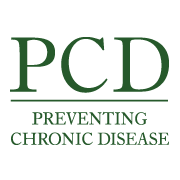PCD News Summary for December 15, 2016

About the Journal
Published every Thursday, Preventing Chronic Disease (PCD) is a peer-reviewed online journal established by CDC’s National Center for Chronic Disease Prevention and Health Promotion. The News Media Branch prepares press summary packets each week. To receive these press summaries on an embargoed basis, send an e-mail to media@cdc.gov. Please note that this e-mail list is for credentialed journalists only. All others, please visit Hookup to Health to sign up for e-mail updates
Notice to News Media - PCD Release Time and Embargo Policy:
CDC’s News Media Branch releases to reporters the PCD media packet every Tuesday afternoon between 12 and 2 pm.
Community Perspectives on Access to and Availability of Healthy Food in Rural, Low-Resource, Latino Communities
Melissa Newton
mnewton@cdc.gov
404-718-6281
Poor and minority people residing in rural food deserts who purchase fresh produce at retail stores often pay more for fruits and vegetables than do residents of urban or majority-area neighborhoods. Despite the higher prices, this produce is often of relatively lower quality. Researchers interviewed and surveyed residents in a rural food desert in Central California. They found that rural residents shop for fruits and vegetables at discount and dollar stores, where produce is more expensive and the quality is poor compared to larger grocery stores. Rural residents in this agriculturally-rich community, however, were able to take advantage of fresh and low-cost produce that was available at fruit and vegetable stands. Residents’ suggestions to improve healthy food access centered on seeking out alternate food outlets, such as fruit and vegetable stands, flea markets, and community gardens.
Influences and Practices in Colorectal Cancer Screening Among Health Care Providers Serving Northern Plains American Indians, 2011–2012
Melissa Newton
mnewton@cdc.gov
404-718-6281
Although most providers surveyed as part of a recent study reported offering colorectal cancer screening to the patients they served at American Indian health facilities, adherence to guidelines on recommended screening practices could be improved. American Indians and Alaska Natives have been diagnosed with colorectal cancer at younger ages and at more advanced stages when compared to whites. American Indians’ and Alaska Natives’ colorectal cancer incidence and mortality varies regionally with the highest rates in Alaska, Northern Plains, and Southern Plains. Researchers note that it is critical to identify colorectal cancer screening practices among health care providers within American Indians and Alaska Natives health systems.
Differences in Food and Beverage Marketing Policies and Practices in U.S. School Districts, by Demographic Characteristics of School Districts, 2012
This first-of-its-kind analysis illustrates that policies and practices intended to restrict marketing of unhealthful foods and beverages or to promote healthful items in U.S. school districts vary by district demographics. Researchers found that policies and practices varied by all of the demographic characteristics examined: the percentage of non-Hispanic white students, metropolitan status, district size, percentage of Title I students, and total annual expenditures per student. Although differences in food marketing practices were found for all of the demographic characteristics included in the study, district size was the most common characteristic for which differences were observed. States should consider these findings when prioritizing training and technical assistance to address food marketing in schools.
Pathways to Health: Association Between Trail Use, Weight Status, and Self-Rated Health Among Adults in Greenville County, South Carolina, 2014
Melissa Newton
mnewton@cdc.gov
404-718-6281
South Carolina adults who reported using trails were half as likely to be overweight or obese and nearly two times more likely to report high self-rated health. This study examined whether adults who reported using the Greenville Health System Swamp Rabbit Trail in South Carolina had lower weight status and better self-rated health compared to adults who did not report using the trail. Prominent rail-trails like the Greenville Health System Swamp Rabbit Trail can have many positive impacts on communities, including providing a place for residents to be active. This study showed a positive association between using the trail and two key health outcomes – weight status and perceived self-rated health, providing support for the development, maintenance, and promotion of these important community resources.
Comparative Analysis of Five Observational Audit Tools to Assess the Physical Environment of Parks for Physical Activity, 2016
Melissa Newton
mnewton@cdc.gov
404-718-6281
Researchers present their 2016 selective review and comparison of prominent audit tools used to assess the physical environment of parks relative to physical activity. There are a variety of well-designed audit tools to evaluate the physical environment of parks for the support of physical activity. The goal of our review was to provide guidance on selecting the best audit tool for a proposed park evaluation project. When selecting an appropriate tool, researchers should review the goal of their project and match their goal with the most appropriate tool.
###
U.S. DEPARTMENT OF HEALTH AND HUMAN SERVICES
CDC works 24/7 protecting America’s health, safety and security. Whether diseases start at home or abroad, are curable or preventable, chronic or acute, stem from human error or deliberate attack, CDC is committed to respond to America’s most pressing health challenges.
- Page last reviewed: December 15, 2016
- Page last updated: December 15, 2016
- Content source:
Error processing SSI file


 ShareCompartir
ShareCompartir